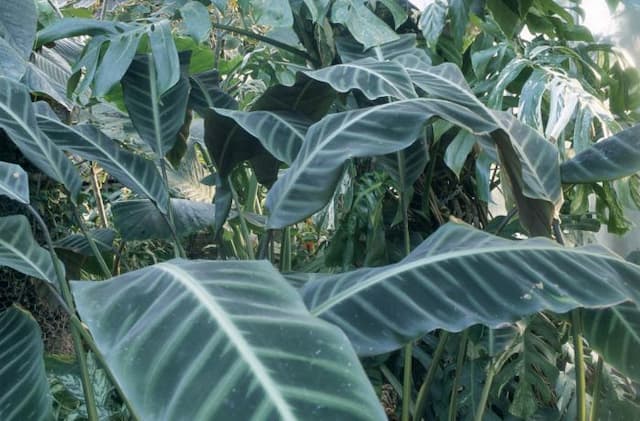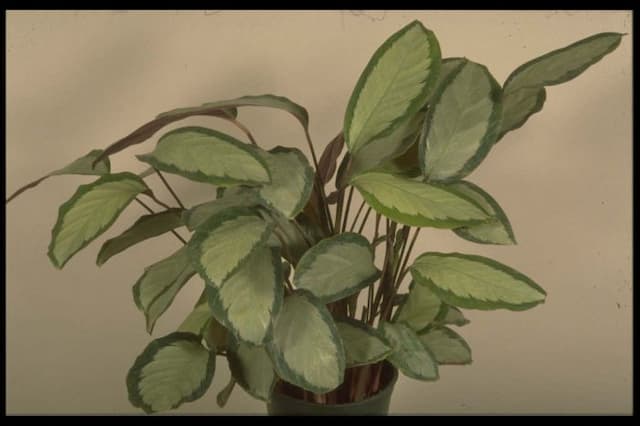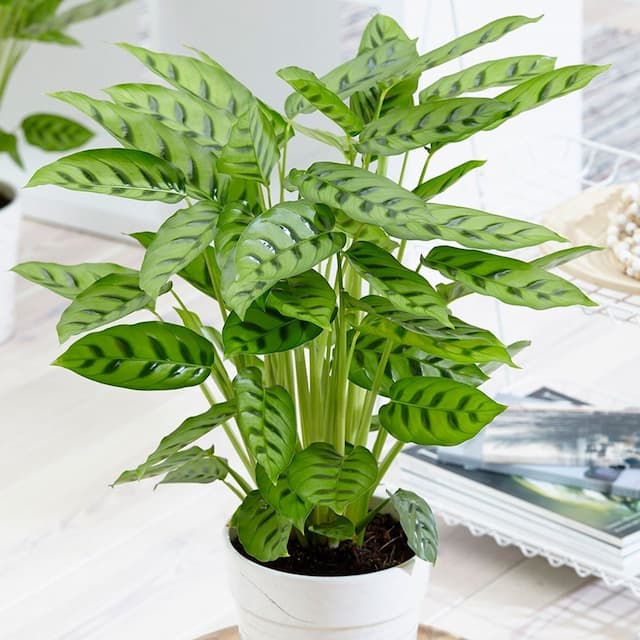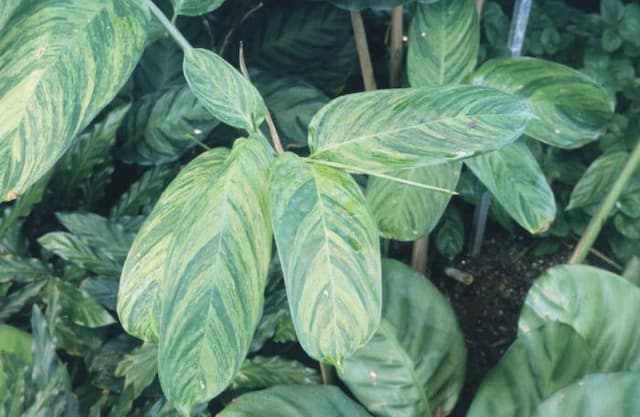Beautiful ctenanthe Ctenanthe amabilis



ABOUT
A perennial herbaceous plant. Indoor Ctenanthe amabilis grows up to 12 inches tall.
This plant is valued for its beautiful leaves. They are dark green, solid, fairly long leaves have many stripes on the surface, diverging asymmetrically from the central vein to the edges. These stripes may be colored yellow, pale green or silver.
Plant's leaves are fairly mobile. They follow the rays of the sun, and can dip and rise.
Flowers do not have any decorative value and the plant indoors blooms very rarely, almost never. The inflorescences resemble a spike or a scallop.
About this plant
 Names
NamesFamily
Marantaceae
Synonyms
Beautiful ctenanthe, Never Never Plant, Stromanthe
Common names
Stromanthe amabilis
 Toxicity
ToxicityTo humans
Non-toxic but avoid ingesting them and keep them away from children. May cause personal intolerance if ingested.
To pets
Non-toxic but avoid ingesting them and keep them away from pets. May cause personal intolerance if ingested.
 Characteristics
CharacteristicsLife cycle
Perennials
Foliage type
Evergreen
Color of leaves
Dark green with yellow, pale green or silver stripes
Flower color
White
Height
18-24 inches
Spread
15-18 inches
Plant type
Shrub
Hardiness zones
9
Native area
Brazil
Benefits
 General Benefits
General BenefitsVery decorative;
Can be grown in a shady room;
Can keep indoor fresh and clean. Medical Properties
Medical PropertiesThe plant takes part in medical developments and research, but has no therapeutic properties of its own.
Interesting Facts
 Feng Shui
Feng ShuiAccording to Feng Shui, it is a plant with masculine Yin energy. It is recommended to put it in the working area, teenager's room, the place where cheerful and noisy companies gather. It helps to avoid conflict situations, protects householders from disease, removes negative energy.
 Zodiac Sign Compitability
Zodiac Sign CompitabilityAQUARIANS
Never Never Plant favors Aquarians. Aquarius loves new and unusual solutions. This potted plant will reflect this trait of character and bring good luck. Plant Symbolism
Plant SymbolismCtenantha is considered the protector of the family home. It is recommended to place it in the bedroom, so that the family has a favorable and loving environment.
There is also an omen that the ctenantha helps to avoid conflicts, protects its owner from diseases and gets rid of negative energy.
 Water
WaterRegular moderate watering is needed. Use soft standing water. Make sure that water does not stagnate in the soil, and that the soil does not dry out. Do not water with cold water.
 Light
LightIt can grow both in a well-lit place and in a shady spot.
It is recommended to place it on a western and northern windows. And also the Ctenanthe can grow on a stand, located near the southern window, but it will need shading from direct sunlight. Temperature
TemperatureYear-round and day-round temperature should be maintained at 68 - 77 °F.
Also it is not advisable to place the plant near a window that opens because the plant can't tolerate drafts. Pruning
PruningDoes not need regular pruning. Only old and diseased leaves should be pruned.
 Cleaning
CleaningAs needed
 Soil
SoilSuitable for Ctenanthe soil mixture consists of peat, coniferous, leaf and humus, as well as a small amount of sand taken in a ratio of 1:1:2:1.
 Repotting
RepottingRepotting is done annually in the spring. Wide flower pots are used for this purpose. Do not forget about good drainage. You can cover the rhizome with moistened moss.
 Humidity & Misting
Humidity & MistingA very moisture-loving plant that is recommended to be sprayed frequently. If the air is too dry, the leaves will start to curl. Advisable systematically arrange a warm shower for the flower, but you should take into account that no drops should remain on the leaves.
 Suitable locations
Suitable locationsIndoor
All year round
Outdoor
Outdoors all year round in USDA 10 and higher.
Hardiness zone
10 - 11 USDA
 Life cycle
Life cycleThis plant can be confused with Calathea, also belonging to the Marantaceae family. These plants are similar to each other, and even botanists cannot agree on their classification.
These plants differ in the structure of their flowers, but when kept in the room blooming in them is quite rare. If you buy a Ctenanthe in a florist's store, you may as well buy a Calathea, as it is almost impossible to it is impossible to distinguish them. Propogation
PropogationPropogation time
Spring
Propagation is simple. In the spring time, when transplanting, you can divide its rhizome. The young plants need a greenhouse effect and warmth until they are fully rooted. Watering should be sparing in this case. During rooting, all foliage may fall off, but the leaves begin to grow very quickly afterwards.
 Pests
PestsSpider mite, Mealybug
 Diseases
DiseasesRoot Rot, Powdery mildew









